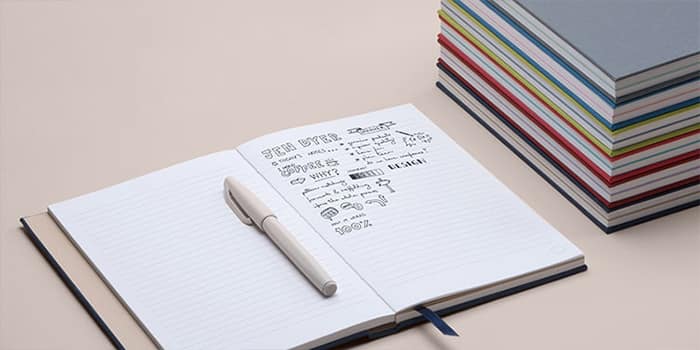8 incredibly creative and artistic business card designs

Here’s how some of our most creative customers took their creative business cards from perfectly practical to miniature artworks.
1. Lucy Jennings
London-based illustrator and designer, Lucy Jennings, opted for our Cotton paper as a canvas for her fun and fruity business card designs.

“I wanted my illustrator business cards to be lighthearted, amusing and memorable. I drew inspiration from the drinks of my childhood – Sunny D, Capri Sun and Slush Puppies – and my nickname, Juicy Lucy. I try to be conscious of my impact on the environment so I chose recycled Cotton paper. The textured finish is an added bonus – I always get compliments on my choice of paper! Printfinity gave me room to explore different colors, styles and ideas – sometimes you can’t fit your whole personality into one card.”
2. By Anna Bay
Anne van den Berg (By Anna Bay) is an illustrator from the Netherlands. She creates many of her sets completely out of paper and she strives to create little worlds for us to get lost in. Her work is minimal, dreamy and always colorful and her artist business cards are no different.

“I always have a portable portfolio with me. People can pick a specific image that they like, which gets them involved and makes it feel like a gift – a few of my contacts are even collecting my business cards! I always get a really enthusiastic response from people when I show them my cards and I’m often asked where I got them from. I love the Original matte paper – I chose it the first time I made an order and it’s become a tradition now.”
3. Dozy Rose
Roza Hamta is a UK-based illustrator and graphic designer who has a bold, playful, millennial-inspired aesthetic that she’s applied to her creative business card designs to best show off her work.
“The reaction to my illustrator business cards on social media has been wonderful. They’ve often been described as ‘pocket size works of art’,” she says. “They’re one of my most shared pieces of work and have attracted a lot of new followers. I also love having the eco-conscious choice to use MOO’s Cotton Business Cards made from recycled t-shirt off-cuts.”
4. Annie Yang
Graphic designer and illustrator, Annie Yang has created a suite of artistic business cards based on her freestyle black marker designs. Combined with bold primary colors and a Spot Gloss finish, she’s created little miniature business card artworks which set her apart from her peers at events and with clients.
“To create my personal cards, I scribbled random black lines with strokes and colors – it was fun not knowing what the end result was going to be. Using Printfinity was great because it allowed me to add Spot Gloss on different areas of each card. I like how my logo catches the light, mimicking the flash of ink, and drawing people in to take a closer look.”
5. Suzie Shin
Chicago-based Graphic Designer, Suzie Shin created her artist Business Cards using the “Space & Sci-Fi” public domain gallery of The British Library. She chose her favorite prints, combined with her logo and printed the finished designs on MOO Cotton paper.
“The inspiration for my logo came from my cultural background. My parents immigrated from South Korea to America, and like most immigrants, they had to decide on two names for their children: one from our culture, and one in English. I was named Suzie, and 수지 (pronounced “Sooji”). In homage to my deeply integrated Korean-American upbringing, my logo features my short nickname “SUZ” and the first characters of my name in Korean. The logo reveals who I am personally and artistically through the use of Korean characters, variable textures and color palette.”
Print your creative business card designs on Cotton.
6. Season of Victory
Freelance illustrator and designer, Lina (Season of Victory) is based in London but her brilliant and bold designs reflect the pop culture she loved growing up and the different cities she’s lived in throughout her life. So do her illustrator business cards!
“I think growing up in Japan and the US really influenced my preference for using color – lots of exposure to crazy cartoons, mass market design, and patterns. I chose the Luxe finish – I wanted the natural, textured feel to contrast with my bold illustrations. I also loved the extra color seam detail. I chose Printfinity so that I could update the business card illustrations when I wanted – switching out the ones I get tired of with new favorites. The quality is great and the colors are rich – very detailed print quality. I’ve always had really dull, corporate cards in the jobs I had in the past, so it was fun to finally create cards in my own style.”
Make your artist business cards stand out with Luxe.
7. Aidan Gooding Donoghue
London-based Graphic Designer Aidan Gooding Donoghue specializes in bright colors and bold drawings to create typographic designs with illusional twists – and beautifully creative business cards.
“I started to work on my own personal branding and obviously needed business card as part of that. Using the logo I created, I decided that the card needed to be bright and bold to stand out. I also wanted the design to be interactive, so by punching holes in the card it would mean that each card would be individual creating a different experience for anyone receiving the card. I decided to use the Soft Touch Super Business Cards as I wanted a matte finish and also knowing that I would be punching holes into the card I wanted them to be sturdy.I love the way that the cards have come out, the colors on it are bold and I feel that it definitely gets a message across and hopefully will make you look!”
8. Mai K. Nguyen
Product Designer + Illustrator Mai Nyguyen lives in California and writes/prints her own comic book series in her spare time. She used MOO Business Cards to create a pack of cards that are completely unique and used them to communicate a very important message. To say they’re some of the most creative artistic business card designs we’ve ever seen would be an understatement!
“I wanted to make a card game to help me propose to my partner. Since this was a personal gift, I only needed one set. It was a bit difficult to find a place to help me print just one deck of playing cards, so MOO’s Printfinity feature worked out perfectly for me. I got the standard matte business cards with rounded corners. The original sizes are nice because it’s closer to the size of a playing card than a regular business card. Plus the texture of the paper and the rounded corners makes for a very nice tactile feel.
“The matte texture of the paper really complements flat business card illustrations – it just gives it a deeper, sharper look to it and my drawings came out looking really nice! The box that it comes in was also a huge plus for me. I was planning on making my own box for the cards so it would look like a real card game, but I ended up just using the box from MOO and customizing it with a label. It’s very sturdy and makes the gift look very special.”
Congratulations to Mai and her partner and thanks for choosing MOO for something so special!
Design your miniature artworks now with MOO Business Cards.
What we’re doing. And what we need to do better.
To all those protesting against racial injustices against Black people – we stand with you. But we know that good intentions and nice words aren’t enough right now. As a business, we need to take action.
From our culture to our collaborations, we’re exploring every aspect of MOO, looking at where we need to change and improve. This will take time, but there are things we can do right now.
One is to amplify the diverse range of Black talent that’s too often been missing from our communications. You have always deserved to be seen, heard and supported. We’re sorry this hasn’t always been reflected and we will do better.
We’re also going to support up to 5,000 small businesses and organizations every year, by giving away $500k worth of print supplies and design services. If you’d like to find out more, email support@moo.com.
Wondering how to promote your business on a budget? Check out these inexpensive marketing ideas for small businesses.
When there’s only a few of you in your company, getting your name out there can be tricky – especially on a small business marketing budget. There are some simple ways to make yourself heard above the noise though. Some of these tips could make all the difference.
Why invest in small business marketing?
Don’t dread the small pull on the purse strings – small business marketing is worth it, if done right. You will…
- be more visible to potential customers
- have a range of tools and platforms to help shape your brand
- learn more about how customers see your products and brand
- add value, engage and entertain your customers, especially through content and social media marketing
- gain new skills and make helpful contacts
Social media marketing for small businesses
When it comes to marketing, social networking sites can be incredibly valuable. They’re free to use, easy to track, and have a huge audience of people who spend a lot of time using them – making it a great place for inexpensive small business marketing ideas.
1. Choose a platform that suits both you and your audience
Successful small business marketing on social media is easier if you’re already familiar with a platform. Look for social media channels you already use and see if your audience is active there too. If not, you may need to broaden your scope, but if the audience fit is right it makes sense to explore what they use.
2. Focus on visual content
With our online attention spans dwindling, visual feeds like Pinterest or Instagram are the ideal platforms for quick, easy-to-consume content that’s engaging and still gives you the chance to land a message. Of course, it depends what type of business you’re in, but it’s best to curate your updates with a mix of inspiring content and promotional links to your own products and services.
3. Add value with Instagram Stories
Stories are where it’s at on Instagram, and brands big and small are thinking of creative ways to use this channel-within-a-channel. A Story is short-lived by nature, disappearing after a day (although you can create replayable highlights if you’ve got an important message you want to keep). They’re great for breaking product news, giving a behind-the-scenes look to tease something new, or to host Q&As between your brand and your audience.
Blog and editorial content
If there’s one thing that’s agreed on in small business marketing, it’s the value of storytelling. Start a blog and you can turn your business journey into ongoing valuable content. Blogging has been around much longer than most social channels, but it remains a great way to tell inspiring stories to your community. As a bonus, it can also add SEO value to your site. Here are some great inexpensive marketing ideas to help make your business blog a winner with readers.
4. Make your blog visual
Add a generous helping of eye-candy to your blog with high-quality photos and visuals. Not only do they break up the text and add interest, they can help customers get a more in-depth look at the products or services you offer. If you have the resources to produce one, an infographic could be another way to up your visual game. Infographics are a way of illustrating or explaining an idea or process in one handy visual. Because of their typically easy-to-read form and typically helpful content, they’re among the most shareable formats around, and a blog makes a great permanent home for them.
5. Expand your reach with guest posting
Bloggers can team up and extend their reach by agreeing to write a guest post for one another’s blogs. This can help you get your name known among a new set of readers who have an interest in your subject matter, but might not have discovered you before. Setting up this kind of partnership gives you access to a much wider audience and it’s a fun form of networking too.
6. Bring in user-generated content
Since their earliest days, blogs have always been about community engagement. Celebrate your customers and fans by posting content they’ve sent in on your blog. This is also a way to show the value of your product, as you can include customer testimonials, show ingenious ways people have used your products and share stories about how they’ve made a difference in someone’s life. Collecting user generated content in a blog post means it’s a permanent feature, rather than a passing moment on social.
Email marketing tips
Encourage customers to sign up to emails from you (maybe by including articles from all that amazing blog content you’re creating), and you’ll have multiple chances to engage with them without spending a penny. If you’re new to digital marketing with your small business, don’t be put off by the many specialist terms out there like conversion rates, click-through rates, re-engagement campaigns and so on. Start off simple, and if email marketing works for you, you can learn more about it in the future. Here are a few small business marketing tips for successful email marketing.
7. Be value-packed
Earn a space in your customers’ inbox by providing a great read, every time. Whether it’s insider news from your business, a curated digest of content from elsewhere around the web, or exclusive promotions and advance access to sales, make sure your email marketing campaigns are a delight to open. Remember, lots of your readers will be accessing their mail from a smartphone, so make sure your email is built for both desktop and mobile.
8. Set up a drip campaign
A drip campaign is a set of emails that are automatically sent out to your subscribers in response to certain behaviours. It’s a way of taking the legwork out of email campaigns using marketing automation. For example, you might have an email that’s automatically sent when someone signs up, or when they’ve not opened an email in a while. You can also use website behaviours, like purchases or visiting certain pages, as triggers.
9. Use segmentation to keep emails relevant
Using email marketing services to segment your audience may mean writing more emails – but you’ll have a much more effective email marketing campaign as a result. As well as separating your transactional emails from your promotional emails, try to split your list by behaviour as well. Write specific content for each of your user groups, such as existing customers, new subscribers and people who haven’t purchased in a while.
10. Offer a referral discount
Recommend a referral partner to your customers and give them a discount when they quote your business name. This works really well for related businesses with a shared audience, such as realtors and interior designers. For example, a designer could offer 10% off furniture for their realtor partner’s clients. A mutual referral program like this is appealing to potential customers on a couple of levels – they’re saving money, and they have one less purchase decision to research and make.
Want more magic marketing tips for your small business? Build your skills with our guide to online advertising and explore our marketing materials range.
With these office space-saving ideas, you can establish your home office in even the smallest of homes.
Cupboard love: the closet office
We know it’s important to draw a clear line between work and leisure time. Ideally, that means shutting the door of your home office at the end of the working day. But what if you don’t have a spare room to use? Well, you could use a closet instead. Yes. Seriously!
Closet offices are converted walk-in cupboards or wardrobes that are just big enough for a desktop, drawers and some shelving. They often have folding doors you can push out of the way while you’re working, so you get the benefit of natural light and warmth from the wider room. Your work chair doesn’t have to fit in the closet – you just need enough space to be able to shut your desk out of sight when you finish work. Here are 25 examples of closet offices to get you inspired.
If you have space for a closet desk but not much left for storage, you could adapt the approach and tuck away your filing system, printer and other equipment in a home office chest. Once you close the lid, nobody will know it contains the secrets of a business genius.
Desks that you can downsize
One of our favorite home office space-saving ideas. A drop-leaf desk is an excellent space-saving idea to magic workspace out of thin air. Attached directly to the wall, it can be lifted up and secured in position for work and then folded down into an unobtrusive shelf when your workday is over.
If a foldaway desk appeals, you may not even need to go shopping – a drop-leaf dining table makes a fantastic desktop and may already be sitting folded away in your home or attic. Failing that, an exploration of eBay or local second-hand furniture spots should lead you to some bargains.
Desks that fold upwards into a cabinet, sometimes called Murphy desks, (after the foldaway Murphy bed), are another smart option that packs some extra storage in. As with all folding options though, it’s best suited for people who can clear everything away with ease – definitely not for lovers of desktop ornaments, stacks of paper or other creative clutter.
Under the stairs, and other nifty niches
Landings, corridors, underneath staircases and even porches can be turned into home offices through sheer force of will. If you have a few feet of space in your home that isn’t regularly exposed to foot traffic, you can use decoration and furnishing to make it into an office nook. Our top home office tips: painting the area a separate color and blocking it off using furniture can emphasize its identity as a dedicated workspace.
When selecting your spot, make sure you’re going to have enough peace and quiet – a corridor leading to a regularly-used room is a recipe for interruptions, especially in a household with young children. Also think about electrical points. With computers, screens, printers, lamps and chargers to take into account, it may be worth getting power outlets installed in your nook rather than dealing with trailing wires.
Portable office space aka the ‘Home Hotdesk’
Take a leaf out of the co-working space book and work anywhere around the house with a home office ‘hotdesk’. Not so much a space-saving office idea as much as one to make you feel less “stuck” in one place.
The key ingredient is a mobile storage trolley you can easily trundle along with you to wherever there’s space and light. It should hold equipment, a laptop, paper, paints and brushes, craft kit or anything else you need. Kitchen trolleys or hostess trolleys can also be great for this type of solution. Or, if you want something sturdier, small workshop tool trolleys might suit your needs. A clever home office idea!
Explore our Wow from home range to keep your home office creative and organized.
Whether you’re an employer or an employee, here are some 10 tips to effectively work from home.
Get into the right mindset for work
Have you been working remotely? Or has it sometimes felt more like you’re remotely working? While people have adapted quickly to changing circumstances, getting the most out of a new WFH workspace can still take some extra discipline and consideration.
It’s hardly surprising. Offices have all those subtle cues and associations that get us into a productive frame of mind. WFH efficiency relies on different factors than office work. While your remote working space at home is in a location you (hopefully!) associate with relaxation and fun. Equally, a lack of structure can lead to overworking and forgetting those all-important screen breaks.
The answer? Develop a homeworking routine that sets you up for a day’s work, not a day snuggled up on the couch with your laptop while Netflix plays in the background, or working late into the night when you could be chilling out.
Get dressed for success
There’s no need to don a suit and shine your shoes for a day of remote work – although if that does the trick for you, we definitely won’t argue – but there’s a lot of power in wearing something that makes you feel energized and capable. Pay attention to what you wear to work. Jump in the shower first thing and put on something that makes you feel ready for the day.
To avoid the twin homeworking pitfalls of wearing pajamas all day and barely moving, Suzie Godfrey, Director of The Sweet Reason Company puts her gym kit on every morning: “Once it is on, I have to do some kind of exercise that day, even if it is only one short workout.”
Suzie takes all of her opportunities to exercise. “I run home from the school drop-off, for two reasons: for fitness, and also because it is quicker than walking, so I have more time to work. Even if it is only a win of seven minutes a day, in a week that is over half an hour. When you are running your own business, every minute counts.”
Use a ‘commute’ to section off work time
Zero commute time might seem like one of the benefits to working from home, but a daily pre-work journey can be a fun experience (we promise!) and has the advantage of getting you into ‘work-mode’. Something that can be a struggle when your home is your office.
Don’t worry, there’s no need to spend money on a travel pass. Start your day by leaving the house and walking a mile – or however far is realistic for you. Turn around, walk back, and let yourself into your ‘office’. You’ll immediately be more efficient. At the end of the day, ‘commute’ home, which will help you switch off from work.
Keep work behind an office door
Even if yours is a ‘kitchen table firm’, try to create a dedicated office space, with a door that you open after your commute and close behind you at the end of the day. This physical barrier between you and your to-do list acts as a psychological barrier to your ‘business brain’. Hopefully making it easier to bring your focus to family and friends, or even just the television after a long day.
If you are sharing your home with others, creating a space where you can remote work is even more valuable. The door to your WFH ‘office’ indicates the start of a professional space and it needs to be treated as such. An important distinction that reminds them (and you) that despite being a remote worker you are doing a ‘proper’ job.
Tricia Dixon, Director of consultancy firm JB Medical says: “Just because you’re working from home, your work and your workspace are as valid as those of people working in a more traditional office. You have to really believe this.”
Sound the alarm when it’s time for a break
As a homeworker, you might find it easy to work long hours without taking a break. Stopping to put another load of washing on doesn’t count as rest, nor does grabbing food from the fridge and taking it back to your desk. Learning how to work effectively implies understanding when it’s time to take a break – especially when there are no colleagues to lure you to the coffee machine for a chat.
Marathon sessions may feel like a productive experience, but, generally, they’re anything but. Being burnt out isn’t helpful for anyone. But if you do find it hard to take breaks, try to look at it with a growth mindset. You’re planning to be successful over the long-term, so you need to work from home sustainably.
To help you get into the habit, set an alarm clock to go off every two hours in the room farthest from your desk. Use these alarms as opportunities to get up and take a break.
Collaborate and communicate
Whether you’re a small business owner or an employee located away from the mothership of a main office, remote work can make you feel removed you from your clients and colleagues. Fortunately, you can keep communication flowing with helpful habits and a healthy dose of communication technology.
Yahoo’s Marissa Meyer famously claimed that being present in the same place as your co-workers is critical to collaboration, and it is indeed easy to become less collaborative when homeworking.
One solution is to embrace online collaboration tools like GitHub, Slack and Trello, to share your ideas and work effectively with colleagues and customers when working from home.
These tools are multi-faceted, with some platforms including voice call, video call and screen-sharing options to help you collaborate while working from home. They’re popular across many different businesses and sectors and have their own communities, allowing you to build your network and connect with new people.
Sometimes though, there’s just no substitute for the experience of meeting face-to-face. For example, if you’re meeting a potential new client or attending an annual review with your manager, being in the same room can really make a difference. In these situations, the kitchen table won’t cut it. Instead, you could try booking a meeting room at a coworking space. This is a great compromise that means you won’t pay as much as you would for your own office.
When you’re working remotely, it’s important to establish boundaries and set expectations, both for you and your colleagues or clients. It’s really important to be clear and proactive about communicating what you will do and when you will do it.
Don’t rely on someone seeing an email about a change of status – follow up with an IM or phone call to make sure they’ve got the message.
Establishing consistent practices like these will help earn trust and build cooperation with people on your team, as they’ll know they can rely on you to do what you say you’ll do and be there when you’re needed. That’s essential for any working relationship, but more than ever when it’s remote work.
The same goes for making sure you’re clear on your WFH hours and availability, especially if you or others on your team are working part-time or across different time-zones. Make sure people know when your ‘desk hours’ are. One option is to add them to your email signature so the information is always at hand for them.
Another helpful step is adding an auto-reply to your email, IM, voicemail and other communication channels so that people know when you’re not picking up their communications. Doing this can help you switch off and enjoy a good work-life balance – even if your workplace is under the same roof as your leisure time.
Defeat distraction and stay focused
Making effective use of your time is a major part of knowing how to work from home. You’re up against a home full of potential distractions, and you’re on your own with the challenge. Daunting? Maybe. Doable? Absolutely – when you have the right tools and techniques at hand.
Here’s a little bit of comfort too – according to The Muse, 23% of wasted time at work comes from socializing with coworkers. At least you don’t have that problem to contend with.
Some common distraction-factors for homeworkers include:
Smartphones and tablets
Smartphones, tablets and other devices that travel on your person can become a real productivity-sucker – especially if you’re someone who routinely reaches for their phone during the day. On average, we touch our phones more than 2,500 times a day, so it’s easy to see how the habit can eat into your work time.
It might sound obvious, but placing devices out of your reach can reduce their power to lure you away from your desk. Try throwing your phone in a drawer or leaving it in another room for a set period while you’re concentrating on a task.
If you’re reluctant to be parted from your phone, for example because you need it to check facts or make calls as you work from home, you can reduce its tendency to ‘ping!’ at the wrong moment. Set up your smartphone’s ‘do not disturb’ mode so you only get essential work-related notifications during working hours.
TV and media
It can be difficult to pay attention when Netflix, Hulu or ESPN are calling to you during the work day. So put a barrier between the TV and yourself.
It could be physical, in the form of a closed office door, or behavioral, where you use psychological barriers to make it tougher to indulge in a mid-morning episode or two. Our favorite work from home tip to stay focused: try unplugging your TV set during the day, so you have to take the extra step of reconnecting it before you can flop down on the couch for a binge-watch.
Household tasks
Under normal circumstances, jobs like washing dishes, laundry or vacuuming might not be go-to activities, but they can suddenly get tempting when your alternative is preparing for a big meeting.
Out of sight, out of mind is a great rule of thumb here. Close the office door so you can’t see housework tasks waiting to be done. If that’s not an option, put laundry baskets and vacuum cleaners in a closet where they can’t absorb your attention.
Pets and family members
They’re adorable, and there’s no denying that they can also be demanding. Although there’s no off-switch, you can try enlisting the help of friends and relatives to take pets and small people off your hands for a few hours, and prioritize your most brain-taxing work tasks for times when they’re not around.
If you’re part of a family or shared household, it can help to establish rules about distracting you during the working day – that earlier tip about having an office door could come in handy here.
Social media
How to work from home effectively when social media is just a click away? One of the most effective tips to work from home is to stay away from social media during work hours.
Job one is to delete any desktop apps you have on your work laptop, as these make it easy to check and update social media, and they can also send you notifications that actively disrupt your concentration.
Another strategy is to work on your browser tab discipline, especially if you’re prone to having your social accounts, webmail and favorite sites open in background tabs all day long. For some people that means doing away with browser tabs altogether. For others, remembering to close every tab apart from the one you’re actively working on can do the trick.
Finally, you can try using social media as a reward for getting those less appealing tasks done. Answer 5 customer service emails, and earn yourself 5 minutes perusing Instagram. Make sure it’s only 5 minutes though – set a timer if you need to.
Having a ‘busy brain’
If your mind is wandering even without outside distractions, mindfulness meditation can help you strengthen your concentration skills and return your attention to your remote work. Even if you’re not a spiritual person, meditation benefits your homeworking mojo, as it trains your brain to focus and filter out distraction. There’s even an academic study that’s shown meditation benefits productivity, concentration and memory in workers.
Stay accountable and stick to your goals
Let’s be honest – peer pressure and management oversight both play a role in driving our motivation at work. It’s easy enough to knuckle down and get on with a work project when your employers can walk by and check out what’s on your screen at any moment. Working from home is simply a different experience – those checks simply aren’t there to keep you on track. It’s the same story with over-work too – the structure of a working day in the office automatically gives you a degree of work-life balance that’s harder to achieve at home.
The same goes for bigger goals and plans related to your career or small business. Keeping your eye on the big picture in terms of your targets and objectives is harder when you’re outside the office environment. It could be getting promoted, acquiring new skills, developing a new product or service, or mentoring others. Whatever the case, your strategic goals can fall by the wayside and get eclipsed by day-to-day activities when there’s nobody else around to help adjust your perspective.
Ben Blomerley, Co-Founder of AskHerFriends feels that “working at home can really undermine your focus. “You don’t have colleagues and bosses around to see whether you’re cruising Facebook or Netflix all day. And you’re often aiming for a large and indeterminate goal (‘I want to make this business succeed’) rather than a specific target (‘make 50 customer service calls today’).”
Ben “breaks tasks down into really narrow and clear portions” to ensure he focuses on what matters. A strategy also employed by Karolina Sieler, Founder/Owner at FBIZZ Women Entrepreneurs Hub. The best way to do this, advises Karolina, is to “prepare your own job description and divide the tasks into administrative ones and the more creative ones.
“You then have to identify a way of monitoring them to make sure that you stay on the right track. I use tailor-made spreadsheets, as well as a combination of online tools such as Asana and Toggl.”
Another tip for working from home effectively is to give yourself a quarterly review. Sit down with a notebook or laptop and look at what you’ve achieved in the last 3 months, what you could have done better, and what you plan to do in the 3 months ahead. This can be really helpful for self-employed workers.
If you’re part of a company you may have the luxury of a manager who can do this with you. But there’s no harm in developing your own ways to keep yourself accountable too. After all, you never know when the opportunity to work for yourself might drop into your lap.
If your challenges relate more to distractions and concentration, consider trying out a co-working space. It’s a way of getting the feel of an office environment and some low-key company while you get your work done. There are no employers to stop you browsing social media all day, but you might find that being around others who are in productivity mode rubs off on you positively.
Finally, you can build accountability by involving other people in your work tasks. If you’re an employee, working on a team project with people in the office can help you feel more connected to your goals and motivated to achieve more. Try setting up regular meetings via phone or video call to give you some structure and a deadline to work towards. For self-employed workers, regular contact with clients and a weekly or monthly check-in call can give you the nudge you need to stay focused on projects.
Now you know how to work from home effectively. Explore our Notebooks & Planners range to keep remote work organized and creative.





















